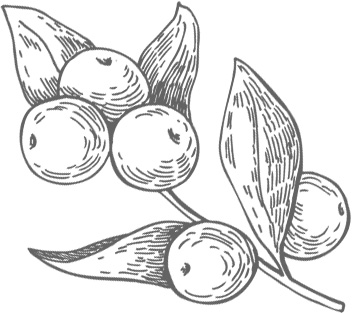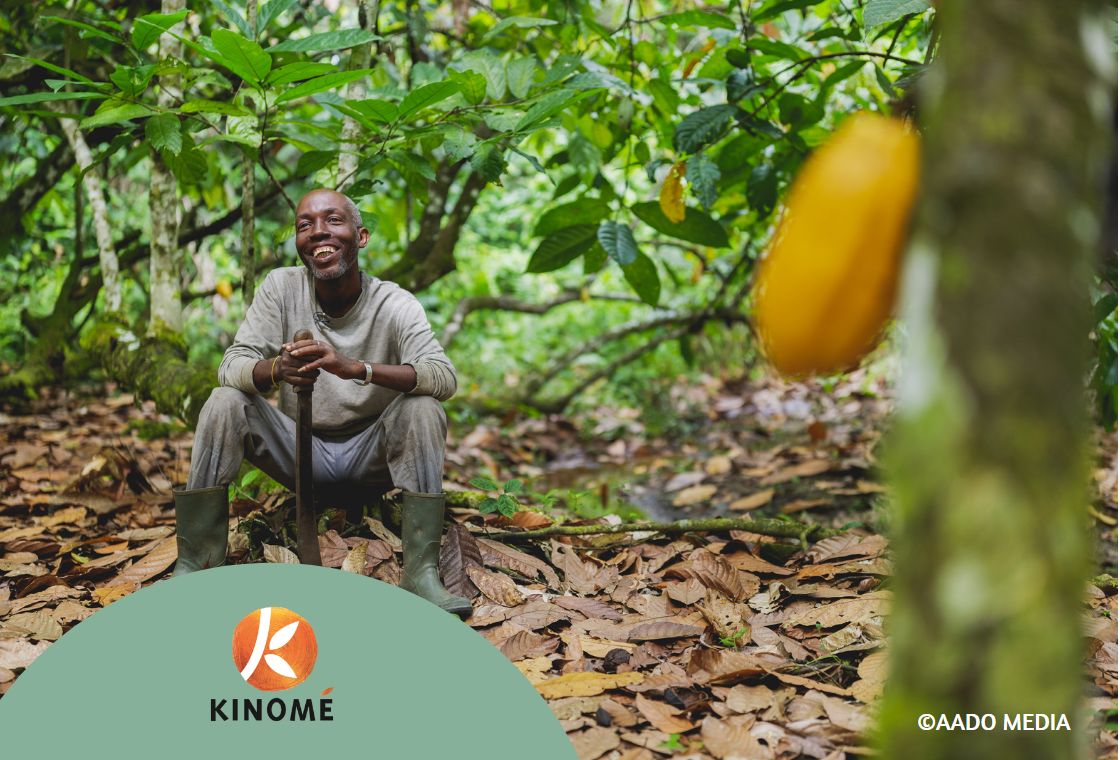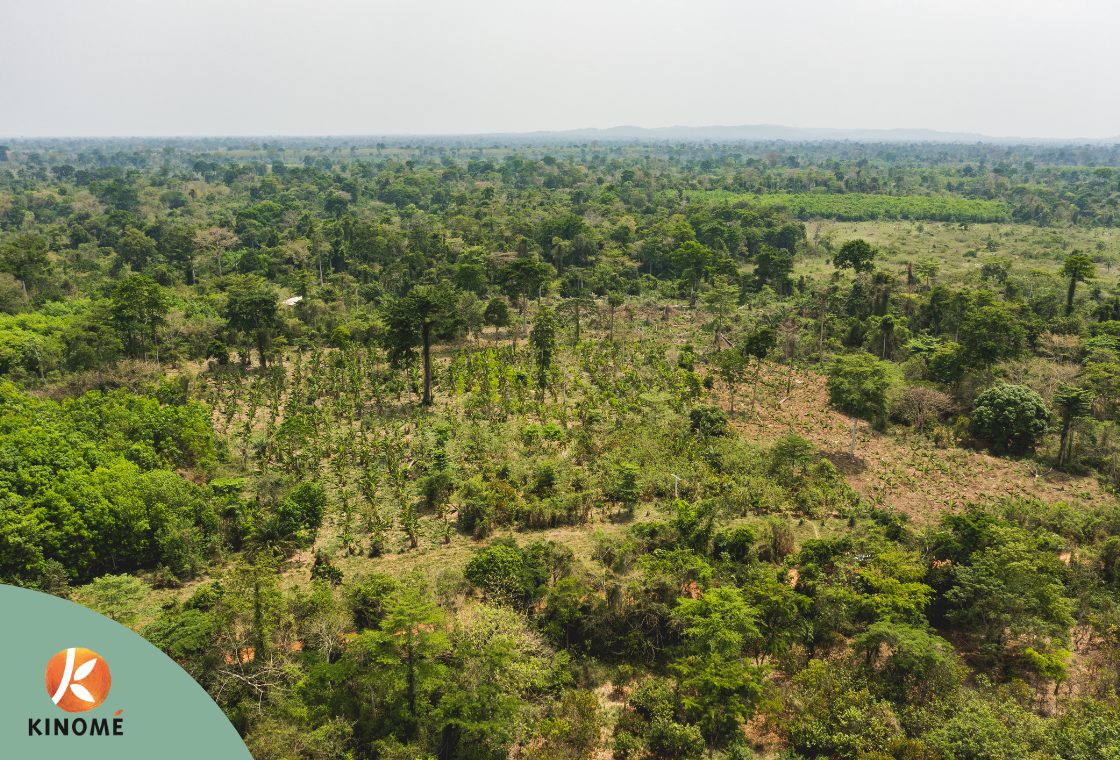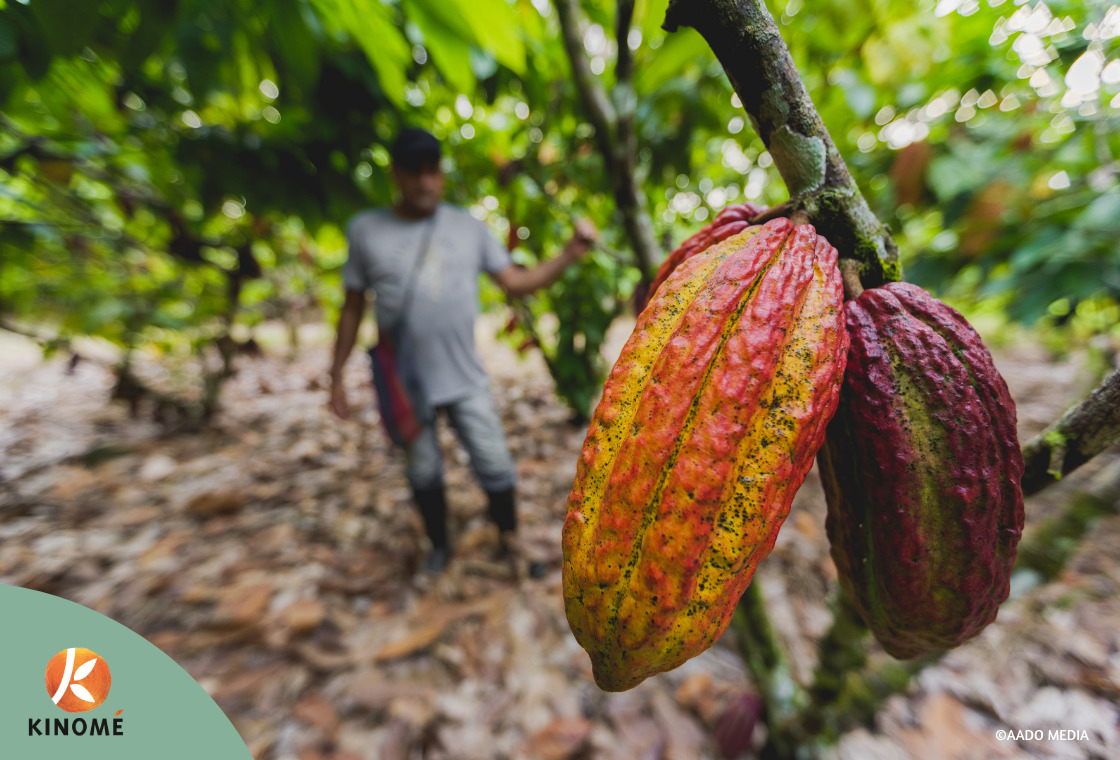How Kinomé studied the potential for sustainable cocoa development in landscapes supported by the PAPFOR project in West Africa
#cocoaculture
Cocoa cultivation is one of West Africa’s most important resources, particularly for Côte d’Ivoire and Ghana, the world’s leading producers. In Ghana and Côte d’Ivoire, the cocoa sector provides income for nearly 1.5 million farmers, and helps maintain 6 million jobs. It is the world’s leading agricultural export.
1. Environmental and social issues in the cocoa sector
The human and ecological factors behind deforestation
Cocoa production is mainly based on small-scale family farms, which sell most of their beans on international markets, which are both unstable and have seen a downward trend in prices for decades. Farmers are poorly organized and dependent on intermediaries. They are therefore forced to sell at very low prices. This situation makes them vulnerable to the industry and forces them to adopt a conventional agricultural model that is proving harmful.
Growers are underpaid and cannot afford to invest in sustainable, capital-intensive practices. Unable to invest in quality inputs and seedlings, they resort to deforestation to gain access to fertile land that does not require fertilizer. Deforestation is favored by the fact that the forest offers an ideal terrain for cocoa. It’s a “free” area, fertile, with no need for inputs and already shaded, which allows young plants to develop.
Unfortunately, the use of child labor allows some to cut costs.
West African cocoa, an extensive crop facing multiple challenges
In recent decades, cocoa-growing practices have been highly dependent on the fertility of forest soils. This mining model is faced with a number of challenges, not least of which is the tendency for yields to fall in plantations, as the initial fertility is not maintained. As a result, national yields are generally low. Faced with ever-increasing global demand, the classic practice was to abandon old, low-yielding orchards to conquer new forest land. Today, with the depletion of forest land, national orchards are aging and often affected by disease. Farmers are increasingly older and lack training and means (agricultural inputs).
Nevertheless, there is a growing awareness on the part of governments, the private sector and consumers alike of the need to change this model. Recent studies and research also point to a spontaneous movement by small producers to reclaim old orchards through agroforestry practices.
2. Sustainable cocoa
Definition of sustainable cocoa
Sustainable cocoa is defined by ISO 34101-3 and ARS 1000 as requiring production methods that are economically viable, socially responsible and ecologically sound. According to ARS 1000, sustainable cocoa is cocoa that meets the needs of the present without compromising the ability of future generations to meet their own needs, including economic, social and environmental aspects. This sustainable cocoa must therefore take into account the various challenges facing the sector, such as providing a decent income, respecting human rights, and preserving the environment and biodiversity.
Beyond definitions, in practice, making cocoa more sustainable means getting different players to work together: governments and legislators to provide a national framework and financial support, but also NGOs and project leaders, more inclusive for the population and enabling concrete, adaptable implementation in the field.
Agroforestry, a sustainable practice
The negative impacts of the cocoa industry are manifold, and call for more sustainable practices that take into account environmental, social and economic issues. Agroforestry, a tool derived from agroecology, is one of the technical options for combating the degradation of forest landscapes, while ensuring food security for local populations. Trees are planted according to a spatial arrangement or temporal sequence designed to take advantage of the ecological and economic interactions between these components. Agroforestry tends to diversify crops and production systems. As a result, land fertility is maintained, leading to higher economic returns and greater robustness to hazards and disease, making crops more perennial. These more resilient systems also provide important ecosystem services (water cycle and carbon sequestration, among others).Longer productive plots can reduce the temptation to clear new forests. However, this must complement the restoration of degraded areas and the strict conservation of forest areas by national forestry authorities.
In short, more sustainable farming practices help preserve ecosystem services, while diversifying producers’ incomes and thus ensuring greater economic stability.
3. Cocoa varieties
Cocoa cultivation is based on three main varieties. Forastero is the most widespread, accounting for around 80% of world production. Criollo is the rarest, accounting for less than 1%. Finally, Trinitario is a hybrid between Forastero and Criollo.
To propagate cocoa trees, we often use grafting, which enables us to reproduce trees with known and desired characteristics. In this way, we choose species that have a good taste, are easy to grow and resistant to climatic conditions and pests, such as :
- Insects,
- Mushrooms,
- Diseases such as brown pod rot.
Different species have specific requirements in terms of light and water. For example, clone CCN-51 is renowned for its high productivity (2 – 2.5 tons/ha), tolerance to diseases such as moniliosis and witches’ broom, and abundant fruiting. The choice of varieties also depends on the target market. Fine, aromatic cocoa is preferred for specialized markets, where the high price compensates for low yields (700 and 900 kilos/ha/year). Otherwise, standard varieties (such as CCN-51) are most often chosen for their higher yields.
4. How the PAPFor and WABILED projects thought about developing sustainable, deforestation-free cocoa in West Africa
Background and objectives of PAPFor and WABiLED projects
The study is part of a collaboration between two programs funded by the European Union and USAID: the PAPFor project, which aims to promote the sustainable management of protected areas and forest lands in West Africa, and the WABiLED project, which aims to preserve biodiversity and promote low-emission development in the region. The aim was to study the principles of developing cocoa that respects the environment and the local communities in the forest landscapes supported by the two programs. To achieve this, it was necessary to take stock of existing initiatives and tools to promote sustainable cocoa farming without deforestation. Kinomé has thus produced a vade mecum listing best practices and recommendations for conservation practitioners.
Faced with the growing demand for cocoa and the risk of increased pressure on natural forests, it is essential to carry out forest conservation and protection projects. The aim of the PAPFOR project is therefore to provide conservation practitioners with a comprehensive set of references and tools to ensure that the “cocoa initiatives” included in the programs financed by the European Union and USAID in the geographical areas of PAPFor and WABiLED, are as effective as possible and contribute to the conservation of the so-called Guinean forests (i.e. the climate zone located in the south of West Africa) and their biodiversity, while supporting the livelihoods of the communities living around the protected and conserved areas.
Solutions and results
The study proposed a set of solutions to ensure that cocoa projects contribute to the conservation of Guinean forests and their biodiversity, while supporting producers’ livelihoods. Kinomé made recommendations on the agronomic, technical, environmental, financial and regulatory aspects of the cocoa sector. These recommendations can be adapted to different situations: whether cocoa farming is just getting off the ground, already exists but can be improved, or already complies with good agricultural practices.
The main sustainability practices recommended are respect for good agricultural practices (choice of appropriate sites, no deforestation, priority given to renewing old orchards, plot maintenance, soil fertility management, etc.), the implementation of agroforestry (association of local species, filling in of empty spaces with shade species or fruit trees, etc.) and other agroecological practices (natural resource management, intercropping, permanent cover, etc.). To improve farmers’ resilience, we recommend diversifying sources of income by diversifying crops and activities.
An agreement on a “call to action” to prevent deforestation due to cocoa cultivation has been reached by stakeholders (government, private sector, agricultural experts, etc.).



#agroforestry #impact #study #investment These articles may be of interest to you Context and issues 1.2.Tree Finance (now RRG Nature-Based...
With the goal of transitioning to a sustainable and inclusive international food system, regenerative agriculture emerges as a powerful force...
#cocoaculture Content Environmental and social issues in the cocoa sector Sustainable cocoa Cocoa varieties Study of PAPFor and WABILED projects...




